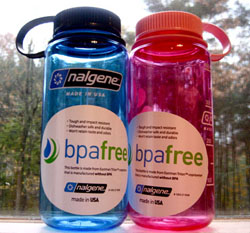
Companies advertise “BPA-free” as a safer version of plastic products ranging from water bottles to sippy cups to toys. Many manufacturers stopped using Bisphenol A to strengthen plastic after animal studies linked it to early puberty and a rise in breast and prostate cancers.
Yet new UCLA research demonstrates that BPS (Bisphenol S), a common replacement for BPA, speeds up embryonic development and disrupts the reproductive system.
Reported in the Feb. 1 edition of the journal Endocrinology, the animal study is the first to examine the effects of BPA and BPS on key brain cells and genes that control the growth and function of organs involved in reproduction.
“Our study shows that making plastic products with BPA alternatives does not necessarily leave them safer,” explained senior author Nancy Wayne, a reproductive endocrinologist and a professor of physiology at the David Geffen School of Medicine at UCLA.
Using a zebrafish model, Wayne and her colleagues found that exposure to low levels of BPA and BPS?equivalent to the traces found in polluted river waters?altered the animals’ physiology at the embryonic stage in as quickly as 25 hours.
“Egg hatching time accelerated, leading to the fish equivalent of premature birth,” said Wayne, who is also UCLA’s associate vice chancellor for research. “The embryos developed much faster than normal in the presence of BPA or BPS.”
The UCLA team, which included first author Wenhui Qiu, a visiting graduate student from Shanghai University, chose to conduct the study in zebrafish because their transparent embryos make it possible to “watch” cell growth as it occurs.
Using fluorescent-green protein tags, the researchers tracked the fishes’ development of reproductive endocrine brain cells, which control puberty and fertility. In a second finding, the team discovered that the number of endocrine neurons increased up to 40 percent, suggesting that BPA overstimulates the reproductive system.
“Exposure to low levels of BPA had a significant impact on the embryos’ development of brain cells that control reproduction, and the genes that control reproduction later in life,” said Wayne. “We saw many of these same effects with BPS found in BPA-free products. BPS is not harmless.”
Wayne suspects that overstimulation of the neurons that regulate reproduction could lead to premature puberty and disruption of the reproductive system. Her lab plans to investigate this question in a future study.
After uncovering her first finding about BPA in 2008, Wayne immediately discarded all of the plastic food containers in her home and replaced them with glass. She and her family purchase food and drinks packaged in glass whenever possible.
“Our findings are frightening and important,” emphasized Wayne. “Consider it the aquatic version of the canary in the coal mine.”
Finally, the researchers were surprised to find that both BPA and BPS acted partly through an estrogen system and partly through a thyroid hormone system to exert their effects.
“Most people think of BPA as mimicking the effects of estrogen. But our work shows that it also mimics the actions of thyroid hormone,” said Wayne. “Because of thyroid hormone’s important influence on brain development during gestation, our work holds important implications for general embryonic and fetal development, including in humans.”
Researchers have proposed that endocrine-disrupting chemicals may be contributing to the U.S.’ rise in premature human births and early onset of puberty over the past couple of decades.
“Our data support that hypothesis,” said Wayne. “If BPA is impacting a wide variety of animal species, then it’s likely to be affecting human health. Our study is the latest to help show this with BPA and now with BPS.”
BPA can leach into food, particularly under heat, from the lining of cans and from consumer products such as water bottles, baby bottles, food-storage containers and plastic tableware. BPA can also be found in contact lenses, eyeglass lenses, compact discs, water-supply pipes, some cash register and ATM receipts, as well as in some dental sealants and composites. The U.S. and Europe were expected to manufacture more than 5 million tons of products containing the additives in 2015.





